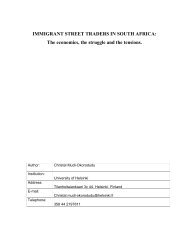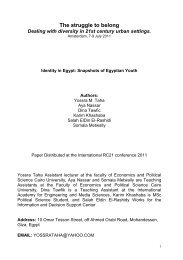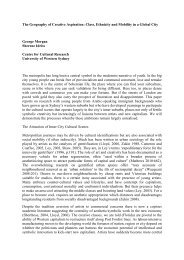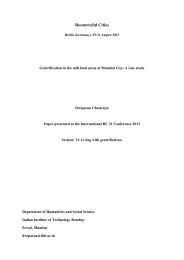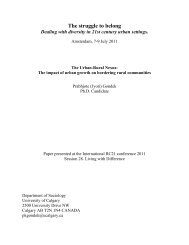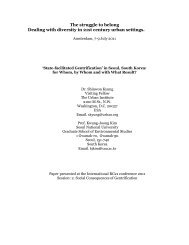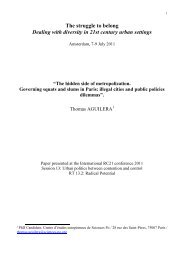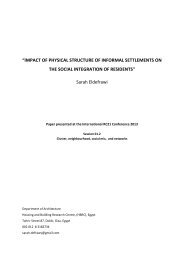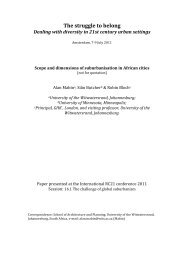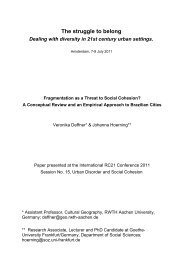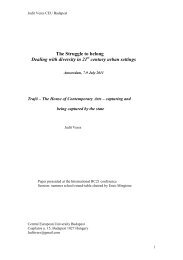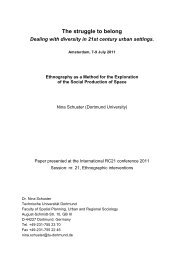White South Africans & The Experience of Gated Living in post ...
White South Africans & The Experience of Gated Living in post ...
White South Africans & The Experience of Gated Living in post ...
You also want an ePaper? Increase the reach of your titles
YUMPU automatically turns print PDFs into web optimized ePapers that Google loves.
ecomes the basis <strong>of</strong> collective identity and belong<strong>in</strong>g, as the irreconcilable social<br />
antagonisms that pervade modern life are avoided. <strong>The</strong> effects <strong>of</strong> this aestheticization and<br />
privatization are multiple: to enhance the aesthetic experience <strong>of</strong> those groups deemed<br />
deserv<strong>in</strong>g; the use <strong>of</strong> space gets restricted to prevent the sight and proximity <strong>of</strong> (racial)<br />
others; the presence and speech <strong>of</strong> strangers becomes def<strong>in</strong>ed as an <strong>in</strong>convenience; the<br />
rights are removed <strong>of</strong> the undeserv<strong>in</strong>g and unwashed.<br />
A central place for aestheticization <strong>in</strong> the analysis <strong>of</strong> the experience <strong>of</strong> liv<strong>in</strong>g <strong>in</strong> gated<br />
communities suggests that elites do not need to speak <strong>in</strong> (racial) code to assert their<br />
(racial) power or (racial) hegemony. <strong>Gated</strong> community should be understood as the<br />
<strong>in</strong>stitutionalization and bureaucratization <strong>of</strong> taste. <strong>The</strong> myth that such communities are<br />
built around the sensuous, passionate, apparently autonomous subjective experience <strong>of</strong><br />
<strong>in</strong>dividuals - be it related to fear, terror or hate <strong>of</strong> the other – should be punctured. What<br />
is more, accord<strong>in</strong>g to the aesthetic logic it is not social relationships that matter for<br />
community but the aesthetic imag<strong>in</strong>ation <strong>of</strong> belong<strong>in</strong>g: the emotional experiences <strong>of</strong><br />
residents that are rooted <strong>in</strong> the historic and aesthetic conception <strong>of</strong> community. In<br />
contrast to psychoanalytic accounts, such an approach suggests that ‗cod<strong>in</strong>g‘ is not<br />
necessary to mask racism for white residents, just as racism is no longer necessary for<br />
exclusion or dom<strong>in</strong>ation. <strong>The</strong> connection between neoliberalism and aestheticization<br />
foregrounds choice and consumption, which makes redundant the cont<strong>in</strong>uation <strong>of</strong> the<br />
more virulent racialized politics <strong>of</strong> the past. v<br />
A short note on the methods <strong>of</strong> this study: as Dupuis and Thorns argue, most studies <strong>of</strong><br />
home and liv<strong>in</strong>g tend to be formalistic <strong>in</strong> their analysis rather than be<strong>in</strong>g based around<br />
first-hand accounts <strong>of</strong> people‘s actual lived experiences (Dupuis 1998). This study takes a<br />
different approach. In the case study <strong>of</strong> Golden Sun presented below, my focus is on the<br />
mean<strong>in</strong>g <strong>of</strong> gated liv<strong>in</strong>g for white Afrikaans female residents and how it reshapes their<br />
experiences <strong>of</strong> crime, race, and community. <strong>The</strong> study is based on three months <strong>of</strong><br />
residence <strong>in</strong> the community and participatory observations, and over forty <strong>in</strong>terviews<br />
with residents, employees and the management staff. vi From the many <strong>in</strong>terviews I did, I<br />
focus on the women <strong>in</strong> this paper because I found them particular articulate about their<br />
aesthetic concerns and few <strong>of</strong> them showed racism <strong>in</strong> the traditional sense. Before I<br />
analyze the discourses <strong>of</strong> the women, I first discuss the governance <strong>of</strong> the community.<br />
1.3 Three Views <strong>of</strong> Golden Sun Estate<br />
Golden Sun is one <strong>of</strong> the oldest and most prestigious security estates <strong>in</strong> Pretoria. With<br />
little more then a thousand households today, and six thousand <strong>in</strong>habitants <strong>in</strong> 2010, it has<br />
become a small city by itself. Orig<strong>in</strong>ally, the estate was built <strong>in</strong> 1990 at the eastern<br />
fr<strong>in</strong>ges <strong>of</strong> Pretoria as a life-style community around a gold course. S<strong>in</strong>ce then, however, it<br />
has expanded to more then triples its size. <strong>The</strong> last ten years the East rand <strong>of</strong> Pretoria has<br />
experienced an explosion <strong>in</strong> urban developments; the area has attracted other gated<br />
communities and a lot <strong>of</strong> commercial development. Today, Golden Sun is no longer an<br />
isolated security estate but part <strong>of</strong> a large conglomerate <strong>of</strong> prestigious (and less<br />
prestigious) estates supported by shopp<strong>in</strong>g malls, fitness centers, schools, and (mega-)<br />
churches. Golden Sun, nevertheless, has rema<strong>in</strong>ed a unique status. A major national<br />
newspaper selected it as the safest community <strong>in</strong> Pretoria, which has translated <strong>in</strong> a<br />
5



